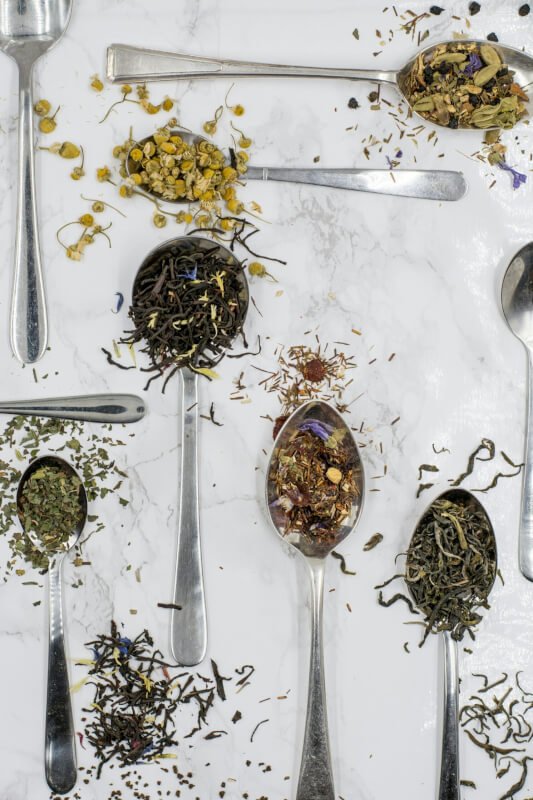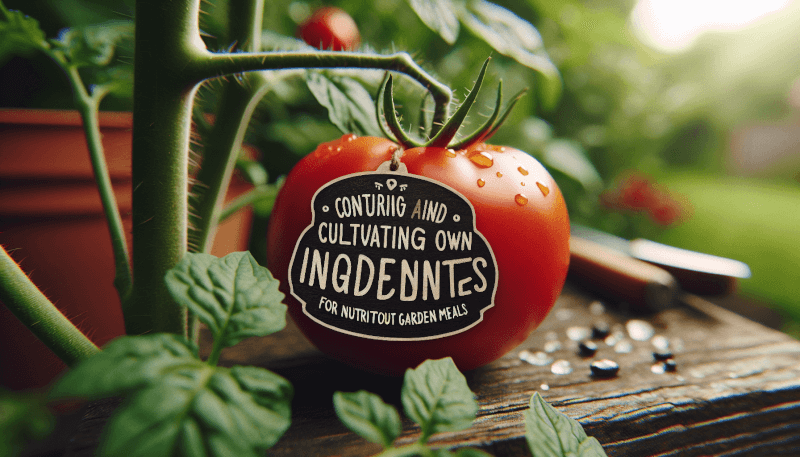Imagine stepping into your own backyard, surrounded by vibrant greenery and fragrant herbs. As you take a deep breath, you realize that these ingredients are not just for admiring their beauty, but for creating delicious and healthy garden recipes. In this beginner’s guide, we will explore the joy of growing your own ingredients, from tomatoes bursting with flavors to aromatic basil leaves, and how to incorporate them into mouthwatering dishes that will impress your friends and family. Get ready to embark on a journey of culinary exploration and experience the satisfaction of harvesting your own ingredients for a truly delectable garden-to-table experience.

Choose the Right Location for Your Garden
When starting a garden, one of the most important factors to consider is the amount of sunlight your garden will receive. Most vegetables and herbs require at least 6 hours of direct sunlight per day to thrive. Take the time to observe your prospective garden site throughout the day to determine the sunniest spot. Once you have found the sunniest location, mark it as your garden spot.
Another crucial consideration is the soil type and quality of your garden site. Different vegetables and herbs thrive in different types of soil, such as loamy, sandy, or clay soil. Conduct a simple soil test by squeezing a handful of soil tightly in your hand. If the soil crumbles easily, it is loamy. If it holds its shape but breaks apart with a gentle tap, it is sandy. On the other hand, if it holds its shape and feels sticky, it is clay soil. Understanding your soil type will help you choose the right plants and know how to amend the soil accordingly.
Proper drainage is also essential for a successful garden. Plants need water, but they don’t like to be sitting in soaked soil. Before deciding on your garden location, check for any signs of excessive water accumulation after rainfall. If you notice puddles or a waterlogged area, it may not be suitable for gardening. Select a spot that allows water to drain well and avoid waterlogged soil, which can lead to root rot and other plant diseases.
Plan Your Garden Layout
Now that you have chosen the right location, it’s time to plan your garden layout. The size of your garden will depend on the available space and the amount of time you can dedicate to tending it. Start small if you’re a beginner and gradually expand as you gain more experience and confidence.
Decide on the type of garden beds that will work best for you. Raised beds provide excellent drainage and make it easier to control the soil quality. They also help create defined spaces for different plants. Alternatively, you can opt for traditional in-ground beds if you have good soil quality and drainage in your garden.
When allocating space for each ingredient, consider the specific needs of the plants. Some plants, like tomatoes or peppers, require more space to grow and may need stakes or cages for support. Leafy greens, on the other hand, can be planted in closer proximity to maximize the growing area.

Select the Right Seeds or Seedlings
Now that you have your garden layout ready, it’s time to select the seeds or seedlings for your garden. Decide on the types of vegetables, herbs, or fruits you want to grow based on your personal preferences and what you use most in your recipes. Consider the seasonality of the plants and choose those that are suitable for your climate.
Research the best varieties of plants for your specific climate. Some varieties are more tolerant of extreme temperatures or resistant to common pests and diseases. By choosing the right varieties, you increase your chances of a successful harvest.
When it comes to deciding between seeds and seedlings, consider your gardening skills and the time you have available. Seeds require more patience and attention, as they need to be started indoors or directly sown in the garden at the right time. Seedlings, on the other hand, provide a head start and can be transplanted directly into the garden. If you’re a beginner or have limited time, starting with seedlings may be a better option.
Prepare the Soil
Before planting your selected seeds or seedlings, it’s crucial to prepare the soil to provide the best growing conditions for your plants. Start by removing any rocks, weeds, or debris from the garden site. These can hinder proper root development and harbor pests and diseases.
Amend the soil with organic matter to improve its fertility and structure. This can be done by adding compost, well-rotted manure, or other organic amendments. Organic matter helps retain moisture, improves soil structure, and provides essential nutrients for your plants.
Ensure the proper pH level for your desired plants. Most vegetables and herbs prefer a slightly acidic to neutral pH range. You can test the pH level of your soil using a simple soil testing kit. If the pH is not within the ideal range, you can adjust it by adding lime to raise the pH or sulfur to lower it.

Plant Your Garden
With the soil properly prepared, it’s time to plant your garden. Follow the recommended spacing and planting depth for each plant, as this will ensure they have enough room to grow and access the necessary nutrients. Overcrowding can lead to stunted growth and increased competition for resources.
After planting, water the plants thoroughly to ensure proper hydration and root establishment. Keep in mind that different plants have varying water requirements, so it’s important to research their specific needs. Regular watering, especially during dry periods, is essential for healthy and productive plants.
Consider companion planting to maximize space and deter pests. Companion planting involves planting compatible plants together to benefit each other. For example, planting marigolds near vegetables can help repel pests and attract beneficial insects. Additionally, certain plants can provide shade or act as a trellis for climbing vegetables, saving space in your garden.
Provide Adequate Care for Your Plants
To ensure your plants thrive, it’s important to provide them with proper care throughout the growing season. Regular and consistent watering is crucial, especially during hot and dry periods. Use a soaker hose or drip irrigation system to water deeply and avoid wetting the foliage, which can lead to the development of fungal diseases.
Mulch the garden to conserve moisture and suppress weed growth. Organic materials like straw, shredded leaves, or wood chips make excellent mulch. Apply a layer around your plants, leaving some space around the stems to prevent rotting. Mulch also helps regulate soil temperature and reduces the frequency of watering.
Enhance plant growth by using organic fertilizers. Avoid synthetic fertilizers that can harm beneficial soil organisms and contaminate the environment. Organic options like compost, worm castings, or fish emulsion provide slow-release nutrients and improve soil health.

Protect Your Garden from Pests and Diseases
Even the most well-cared-for gardens can be vulnerable to pests and diseases. To protect your garden, install barriers or nets to keep out pests like rabbits, deer, or birds. Additionally, consider using row covers to prevent pest infestations while still allowing sunlight, air, and water to reach your plants.
Practice crop rotation to prevent the buildup of pests and diseases in your garden. Crop rotation involves changing the location of your plants each year to disrupt the life cycles of pests and diseases that may have overwintered in the soil. It also helps replenish soil nutrients unevenly depleted by different plant families.
When dealing with specific pests, opt for organic pest control methods. These can include hand-picking pests, using insecticidal soaps or organic sprays, or introducing beneficial insects, such as ladybugs or praying mantises, to combat common garden pests.
Harvest Your Ingredients
The moment you’ve been waiting for has arrived – it’s time to harvest your homegrown ingredients! Check for signs of ripeness for each plant. Vegetables like tomatoes should be fully colored and slightly soft when touched. Leafy greens can be harvested when they reach the desired size, usually before they bolt or flower.
Use proper harvesting techniques to ensure you don’t damage the plants or the remaining fruits. For most vegetables and herbs, use clean and sharp garden shears or scissors to cut the stems just above the soil level. Be gentle when handling fragile fruits, like berries or delicate herbs.
For the freshest flavors, harvest your ingredients in the morning when they have had a chance to cool overnight and haven’t been exposed to the heat of the day. This is when the flavors are most concentrated, and the plants are at their peak freshness.

Store and Preserve Your Harvest
To enjoy the fruits of your labor for a longer period, it’s important to properly clean and store your harvested vegetables and fruits. Remove any soil or debris, and gently wash them with water if necessary. Allow them to air dry fully before storing.
Consider canning or freezing excess harvest to preserve them for future use. Canning involves processing the vegetables or fruits in jars with heat to kill bacteria and prevent spoilage. Freezing, on the other hand, involves blanching the vegetables to preserve their texture and color before packing them in airtight containers or freezer bags.
For the herbs you’ve grown, drying is an excellent way to preserve their flavors. Hang them upside down in a well-ventilated area away from direct sunlight until completely dry. Once dry, remove the leaves from the stems and store them in airtight containers in a cool, dark place.
Experiment with Garden-Fresh Recipes
Now that you have a bountiful harvest, it’s time to unleash your inner chef and experiment with garden-fresh recipes. Browse recipe books or websites for inspiration on how to incorporate your homegrown ingredients into delicious dishes.
Try different cooking methods to showcase the flavors of your homegrown ingredients. Roasting or grilling vegetables can enhance their natural sweetness and add a smoky flavor. Fresh herbs can be used as seasonings in dressings, marinades, or as a finishing touch to elevate the flavors of your dishes.
Last but not least, enjoy and share your delicious creations with friends and family. There’s something truly special about savoring the taste of your own homegrown ingredients and sharing the joy of gardening and cooking with loved ones. Happy gardening and bon appétit!

